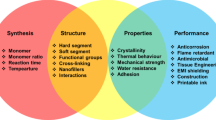Abstract
The present status and development trends of nano-composite coatings were briefly introduced. The nano-SiO2 was dispersed into crylic acid resin by ultrasonic wave and high-energy ball milling, the influence of nano-SiO2 on shielding property of coatings was investigated. Relation between particle size distribution of original nano-SiO2 and its dispersal in water and alcohol after treatment were analyzed, respectively. The ultraviolet permeation rate of coatings filled with nano-SiO2 was detected by ultraviolet spectral photometer. And the particle size distribution of coatings was examined by TEM. The results show that particle size distribution is comparative convergence and smaller one order of magnitude after dispersal treatment. The size of most nano-SiO2 in coatings is smaller than 100 nm, which indicates that the amount of nano-SiO2 in the resin is 20% (solid content of resin), the permeation rate of ultraviolet of composite coatings decreases to 20%. The research of its excellent ultraviolet shielding property mechanism indicates minor size and high surface energy of nano-SiO2 can produce different absorption, reflection and scatter actions to different wavelengths.
Similar content being viewed by others
References
WANG Ding. Development of crylic acid long term anticorrosive coatings [J]. An Hui Chemical Engineering, 2000, 103(2): 32–35. (in Chinese)
LI Zhi-hua, LI Guo-lai. Structure design and characterization of waterbased polyurethane modified by crylic acid resin [J]. Paint & Coatings Industry, 2000, 103(2): 3–6. (in Chinese)
ZHANG Zhi-kun, CUI Zuo-lin. Nano-technology and Nano-material[M]. Beijing: Defense Industry Press, 2000. (in Chinese)
ZHU Yu-shu. Application of nano-materials in coatings[J]. Paint & Coatings Industry, 2000, 30(9): 3–5. (in Chinese)
LIU Fu-chun, HAN En-hou, KE Wei. Present status and development of Nano-composite coatings[J]. Materials Protection, 2001, 34(2): 1–4. (in Chinese)
ZHANG Dong-xing, GU Da-ming. Nano-technology and coatings [A]. Material Research Institute. The 2th Conference of Application of Nano-material and Technology[C]. Beijing: Material Research Institute Press, 2001. C94-C97. (in Chinese)
WU Li-min, ZHOU Shu-xue. Application of nano-material in coatings [A]. Material Research Institute. The 2th Conference of Application of Nano-material and Technology[C]. Beijing: Material Research Institute Press, 2001. C36-C39. (in Chinese)
ZHAO Yun-feng. Application and prospect of nanomaterial technologu in the field of aviation[A]. Material Research Institute. The 2th Conference of Application of Nano-material and Technology[C]. Beijing: Material Research Institute Press, 2001. F63-F66. (in Chinese)
XU Bin-shi. Nano Surface Engineering[M]. Beijing: Chemical Engineering Press, 2004. (in Chinese)
Zhoushan Mingri Nano-materials Limited Company Brief Introduction of Nano-SiO x [A]. Material Research Institute. The 2th Conference of Application of Nano-material and Technology[C]. Beijing: Material Research Institute Press, 2001. Q3–Q4. (in Chinese)
wANG Rui-gang, WU Hou-zheng, CHEN Yu-ru, et al. Development of steady dispersion of ceramic slurry[J]. Material Science and Engineering, 1999, 17(2): 66–70. (in Chinese)
SONG Zhe, GAO Lian, LI Qing. Study on the surface status and agglomeration of TiO2 nano-powder [J]. Journal of Inorganic Materials, 1997, 12(3): 445–448.
Bertoncello R, Furlanetto F, Guerriero P, et al. Electrodeposited composite electrode materials: effect of the concentration of the electrocatalytic dispersed phase on the electrode activity [J]. Electrochimica Acta, 1999, 44: 4061–4068.
Stamataskis P, Palmer B R. Optimum particle size of titanium dioxide and zinc oxide for attenuation of ultraviolet radiation[J]. Journal of Coatings Technology, 1990, 62(7): 95–98.
XU Guo-cai, ZHANG Li-de. Nano-composite Material[M]. Beijing: Chemical Engineering Press, 2002. (in Chinese)
Author information
Authors and Affiliations
Corresponding author
Additional information
Foundation item: Project(2001ZB05) supported by Maintenance and Innovation in 2001
Rights and permissions
About this article
Cite this article
Yan, R., Wu, H., Ma, Sn. et al. Ultraviolet shielding property of crylic acid resin filled with nano-SiO2 . J Cent. South Univ. Technol. 12, 226–229 (2005). https://doi.org/10.1007/s11771-005-0046-5
Received:
Accepted:
Issue Date:
DOI: https://doi.org/10.1007/s11771-005-0046-5




